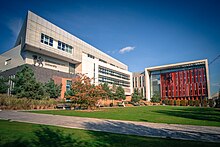Birmingham City University
 | |
Former names | Birmingham College of Art, Birmingham Polytechnic, University of Central England in Birmingham |
|---|---|
| Motto | Template:Lang-la |
Motto in English | "Do what you are doing; attend to your business" |
| Type | Public |
| Established | 1992—gained university status 1971—City of Birmingham Polytechnic 1843—Birmingham College of Art |
| Endowment | £5.3 m (2015)[1] |
| Chancellor | Sir Lenny Henry |
| Vice-Chancellor | Professor Philip Plowden[2] |
| Students | 26,930 HE (2022/23)[3] |
| Undergraduates | 20,940 (2022/23)[3] |
| Postgraduates | 5,990 (2022/23)[3] |
Other students | 275 FE |
| Location | , , United Kingdom 52°31′2″N 1°53′53″W / 52.51722°N 1.89806°W |
| Campus | Urban (multiple) |
| Affiliations | Skillset |
| Website | www.bcu.ac.uk |
Birmingham City University (abbrev. BCU) is a modern university in the city of Birmingham, England. Initially established as the Birmingham College of Art with roots dating back to 1843,[4] it was designated as a polytechnic in 1971 and gained university status in 1992.
The university has three main campuses serving four faculties, and offers courses in art and design, business, the built environment, computing, education, engineering, English, healthcare, law, the performing arts, social sciences, and technology. A £125 million extension to its campus in the city centre of Birmingham, part of the Eastside development of a new technology and learning quarter, is opening in two stages, with the first phase having opened in 2013.[5][6]
It is the second largest of five universities in the city, the other four being Aston University, University of Birmingham, University College Birmingham, and Newman University.[7] It is ranked third of the five according to the Complete University Guide, below both the University of Birmingham and Aston University.[8] Roughly half of the university's full-time students are from the West Midlands, and a large percentage of these are from ethnic minorities. The university runs access and foundation programmes through an international network of associated universities and further education colleges, and has the highest intake of foreign students in the Birmingham area.[9]
History
Birmingham Polytechnic
In the 1960s, changes were made to the higher education system creating an expansion of polytechnics as a more vocationally orientated alternative to the typical university.
The City of Birmingham Education Committee was invited to submit a scheme for the establishment of a polytechnic bringing together a number of different colleges in the city in 1967.[10] Late in 1969, the post of director of the polytechnic was advertised.[11] Although the city lagged behind other parts of the country,[12] Birmingham finally gained a polytechnic in 1971—then the 27th in the UK[13]—designated by the Education Secretary Margaret Thatcher as the City of Birmingham Polytechnic. This was the second polytechnic in Birmingham, the first – Birmingham Polytechnic Institution – having existed in the mid-19th century for ten years.

It was formed initially out of five colleges. Some of the colleges' staff fought against the merger[14] but later changed their minds. The colleges were:[13]
- Birmingham College of Art and Design (originally the Birmingham Government School of Design, founded in October 1843);
- Birmingham School of Music (developed as a department of the Birmingham and Midland Institute around 1859);
- Birmingham College of Commerce (established in the early 20th century as a branch school of the Birmingham Central Technical College, which went on to become Aston University);
- South Birmingham Technical College (opened in 1961);
- North Birmingham Technical College (formerly Aston Technical College, opened in 1966).
The latter's new Perry Barr campus (which began construction in 1971) became the centre of the new Polytechnic, although the institution continued to have a number of different campuses spread across the city. This has sometimes been seen as a weakness of the polytechnic, with the dispersal of sites considered confusing to visitors.[15]
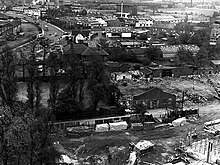
In the early 1970s, the Perry Barr campus was the site of building work for what later became the centrepiece of the polytechnic: the Attwood and Baker buildings. Later in the 1970s, the campus was increased in size with the building of what later became the Cox, Dawson, Edge, Feeney and Galton buildings. In the early 1980s, the William Kenrick Library was added to the site. Although smaller buildings were subsequently constructed, this is largely the Perry Barr campus as it remains today (now called the City North Campus of Birmingham City University).
From its opening, the polytechnic was considered very strong in the field of art and design. As early as 1972, fashion and textile courses were heavily oversubscribed; there were 100 applications for every 30 places.[14] Also in that year, the polytechnic held the Design in a Polytechnic exhibition, which was opened at a reception hosted by Sir Duncan Oppenheim, the chairman of the Council of Industrial Design.[16] Arts courses remained strong at the polytechnic through the 1970s, with twice as many arts students compared to those doing engineering or technology courses.[17]
In 1975, three more colleges were added to the polytechnic:
- Anstey College of Physical Education (founded as a private college for women in 1897);
- Bordesley College of Education (founded as a Local Education Authority (LEA) Day Training College for women teachers in 1963);
- City of Birmingham College of Education (founded as an LEA Emergency Teacher training college in 1948).
In the mid-1970s, the polytechnic's then-chairman, William Kenrick, sparked criticism from politicians for saying his students were "second-class" students.[18] In 1978, a lecturer in law, Francis Reynolds, was convicted and fined £150 for preparing instruments of property conveyance without being a solicitor. He did this to challenge the monopoly solicitors held over conveyancing, which he felt led to higher costs.[16]

By 1979, the polytechnic was one of the biggest in the country, though that did not prevent it from being "starved" of resources and money. There was a concern that without sufficient investment, the quality of its degree courses in areas such as engineering could not be maintained to the desired standard.[19]
In 1988, the Birmingham Institute of Art and Design (BIAD) was established from the merging of the polytechnic's Faculty of Art and Design with Bournville College of Art. The extensive archives from these earlier incarnations, including over 10,000 artworks, were housed at the polytechnic's Margaret Street campus.
Following the UK Government's Education Reform Act in 1989, the polytechnic ceased to be under Birmingham Local Education Authority control and became an independent corporation with charitable status.[20] It was funded by the Polytechnics and Colleges Funding Council and no longer by the local education authority. The polytechnic continued to have close links to Birmingham City Council, and to this day the Lord Mayor of Birmingham also serves as the University's Chancellor.
The change in status enabled a tighter union between the polytechnic and industry, and by 1989 it had 30 lecturer's posts sponsored by firms.[21]
University status
The Further and Higher Education Act 1992 allowed all polytechnics to adopt the title of "university". The name University of Central England in Birmingham was approved by the Privy Council on 16 June 1992. The name change took place in time for the new academic year starting later that year. Students who graduated in mid-1992 were given certificates bearing the name University of Central England, even if the entirety of their study had taken place at the polytechnic. The original design was created by Amba Frog Design[22] after a meeting with delegates from university student councils.
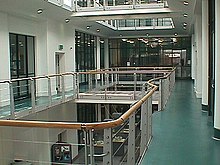
In 1995, two more colleges were absorbed—Birmingham and Solihull College of Nursing and Midwifery, and the West Midlands School of Radiography—and the Birmingham School of Jewellery opened on Vittoria Street in Birmingham's Jewellery Quarter. The Faculty of Engineering and Computer Technology provided the basis for the creation of the Technology Innovation Centre (TIC) in 2000. The following year, the Faculty of Health incorporated the Defence School of Health Care Studies.
In November 2003, the university pursued a merger between UCE and Aston University-another university in Birmingham,[23] that, according to The Guardian, "would create an institution of 32,000 students with a £200m turnover".[24] The plans were announced by the then Vice-Chancellor Peter Knight, and approved by lecturers.[25] The new institution would use the established Aston University name, and all UCE staff members' jobs and employment conditions would be kept intact, although Vice-Chancellor Knight would not be part of its management team. He estimated a completion date for the merger of August 2006.[26]
Michael Sterling, vice-chancellor of University of Birmingham, welcomed the initiative and said it was time for some creative thinking about higher education in the city. "Clearly, with three very distinct universities in one city, it's sensible to take a hard look at the big picture and how we can best work together, whether separately, in combination, or even as one institution," he said. His intervention provoked a furious reaction from Peter Knight, vice-chancellor of UCE, who made it clear his approach was only to Aston University.[27]
The Aston University Council discussed the proposal during a meeting on 3 December 2003 and concluded that it should be rejected. Aston University said that "Whilst the Council respects UCE's distinctive mission, it does not share UCE's analysis of the potential opportunities that might arise from any merger", and cited influencing factors such as Aston's approach to research and teaching, the "significant differences between the missions and strategies" of Aston and UCE, and the negative impact that prolonged discussions would have on both institutions.[28] Aston suggested that it, UCE and the University of Birmingham should instead begin discussions about the three universities' contribution to the future of local and regional higher education.[28]
In August 2005, the University of Central England rebranded itself as UCE Birmingham for marketing and promotional purposes, though the original name remained for official use. This decision was reversed in March 2007, following the arrival of a new Vice-Chancellor, and the fuller title University of Central England in Birmingham was resurrected for all purposes.
Renaming
In June 2007, it was announced that the University would be renamed from 'UCE Birmingham',[29] with three possible names being proposed: Birmingham City University, Birmingham Chamberlain University, and Birmingham Metropolitan University.[30] Staff and students (both current and alumni) were asked to complete a survey on what they wished the name to be changed to. On 1 October 2007, Vice-Chancellor David Tidmarsh unveiled the name change from UCE Birmingham to Birmingham City University.[31] 48.2% of those who voted on the survey voted for this name,[32] although 62.1% of staff had voted for Birmingham Metropolitan University.[33] The University of Birmingham Council had previously advised UCE that their preferred choice was Birmingham Metropolitan University, and that it considered Birmingham Chamberlain University "unacceptable" because of Joseph Chamberlain's historic involvement and association with the University of Birmingham.[30]
The proposed name change was met with mixed reaction from students and student union officials.[34] A common argument was that money should be spend on facilities and building repair work, and some students felt ignored by the establishment. The rationale for the name change was a perceived confusion of the location of the university and to give a "shorter, more powerful name".[35] The rebranding of the university, which included changing signage and stationery,[36] cost £285,084.[37]
The university's current logo, designed by Birmingham-based BHMG Marketing,[36] is based on the tiger in the crest originally used when it was awarded university status.[38] The crest itself originated from the Birmingham College of Commerce, one of the institutions that formed the polytechnic in 1971. In 2009, the logo was revised to include the word "CITY" in upper-case on the first line instead of in lower-case on the second.
Campuses
Throughout its history the university has been spread across a number of different sites in Birmingham. As of 2018, the university is at the following campuses:

- City Centre Campus, located is the home of Birmingham School of Acting and the Faculty of Computing, Engineering and the Built Environment inside Millennium Point. The Parkside Building, adjacent to Millennium Point and connected to it via a bridge, opened its doors in 2013, housing Birmingham School of Media and design courses from the Faculty of Arts, Design and Media. The Curzon Building houses the Faculty of Business, Law and Social Sciences and the School of English, as well as the library, Students' Union and other support services. Royal Birmingham Conservatoire, moved to the City Centre Campus in 2017.
- Vittoria Street in the Birmingham Jewellery Quarter, home to Birmingham School of Jewellery.
- Margaret Street, home of the School of Fine Art, formerly home of the Birmingham School of Art.
- City South Campus, on Westbourne Road in Edgbaston, home to both the university's health, education and life sciences courses and a moderate amount of student accommodation.
- Bournville Campus, home to Birmingham City University International College.[39]
The university has completed a "flagship" extension to its campus in Birmingham City Centre, next to the existing facilities at Millennium Point. The City Centre Campus is a £150 million scheme, as part of Birmingham's Eastside development, with design and media students moving into Phase 1 of the development in 2013, from the former Gosta Green Campus and City North Campus, respectively. Business, English, law and social sciences followed when Phase 2 of the new building was completed in 2015.[6]
As of September 2017, Birmingham City University invested approximately £220 million into campus infrastructure while moving its campus into the city centre. The university focused on building cutting-edge facilities for students and updating internal systems used for human resources and finance. The university purchased Oracle ERP Cloud and HCM Cloud to update its IT strategy and standardise employee-facing functions, which became crucial in the institution's efforts to modernise its IT infrastructure.[40]
Facilities
University House (formerly known as the New Technology Institute or NTI) is located close to the City Centre Campus and is home to a number of the University's professional service departments. The International Project Space (IPS) is an art gallery located at the Bournville Centre for Visual Arts.
Moor Lane is a venue for sports, business training and conferences near to City North Campus. Previously, a dedicated sports centre was located behind The Coppice, a student accommodation block next to the former City North Campus, and included tennis courts, bowls, football and rugby pitches, running track and a social club. The university announced a £7 million sports complex would be built on the site, formerly the Ansells Sports Club, with construction to start in mid-2008 for completion in 2009.[41] The centre, Doug Ellis Sports Centre, opened on 4 January 2010 and includes a fitness suite, workout classes, and a sports hall.[42] Lawyers at Wragge & Co have advised Birmingham City University on the outsourcing of work for the sports centre to international service company Serco. Under a new 10-year agreement, the FTSE 100 company will run both the sports centre and the existing Pavilion sports facility in Perry Barr.[43]
Accommodation
The Coppice and Oscott Gardens are residential halls of residence located adjacent to former City North Campus. The university also offers accommodation in a number of privately owned halls of residence, these include Jennens Court, My Student Village: Birmingham (formerly clv Birmingham) and Curzon Gateway in the city centre.[44] There are also halls of residence at the City South Campus, primarily used by nursing students.
Organisation and governance
Chancellors
After the former Birmingham Polytechnic was granted University status it installed the city's Lord Mayor as its Chancellor each year. It was one of only two national institutions to adopt this link with its local region.[45] On 21 July 2016 the University announced[46] that Lenny Henry would become its new Chancellor, for a term of five years.
| Name | Duration |
|---|---|
| Chauhdry Abdul Rashid | 2008–2009 |
| Michael Wilkes | 2009–2010 |
| Len Gregory | 2010–2011 |
| Anita Ward | 2011–2012 |
| John Lines | 2012–2013 |
| Mike Leddy | 2013–2014 |
| Shafique Shah | 2014–2015 |
| Ray Hassall | 2015–2016 |
| Sir Lenny Henry | 2016– |
Faculties and schools
Birmingham City University is a large university and has departments covering a wide range of subjects. The university's system was re-organised into four faculties in September 2014,[47] composed of numerous schools and departments.
Faculty of Arts, Design and Media
It has been suggested that Birmingham Institute of Art and Design be merged into this article. (Discuss) Proposed since September 2018. |
This faculty includes the art and design related courses taught by the School of Art, School of Architecture, School of Fashion, Textiles and 3D Design, School of Jewellery and School of Visual Communication.
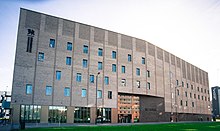
It is also home to the Royal Birmingham Conservatoire, an international conservatoire and junior school and a major concert venue for many of Birmingham's principal concert promoters and organisations, hosting over 300 events annually;[48] Birmingham School of Acting, which merged with the university in 2005 following a period of collaboration;[49] the School of English; and Birmingham School of Media, one of the first media schools in the country to teach media as part of the Skillset Academy Network. Its courses have received approval from the Broadcast Journalism Training Council and the Chartered Institute of Public Relations.[50]
Faculty of Business, Law and Social Sciences
This faculty includes Birmingham City Business School, a major centre for business, computing and management education. It incorporates three academic departments and two specialist centres:[51] the Department of Accountancy and Finance, the Department of Business and Marketing, the Department of Management and Human Resources, the Centre for Leadership and Management Practice, and the Centre for Internal Audit, Governance and Risk Management. It also includes the university's School of Law and School of Social Sciences.
Faculty of Health, Education and Life Sciences
The University is among the UK's largest higher education centres for health and social care. The faculty includes the Defence School of Health Care, which is part of the Royal Centre for Defence Medicine (RCDM).[52] It also provides courses for intending teachers, serving teachers or those simply interested in education issues covering the entire range of school phases from infant to continuing education, at every study level from full-time undergraduate to postgraduate level and PhD.[53]
Faculty of Computing, Engineering and the Built Environment
The Faculty of Computing, Engineering and the Built Environment, based in Millennium Point, is a national centre of excellence for learning, innovation and technology transfer.[54] The faculty was temporarily known as the Faculty of Technology, Innovation and Development (TID) from 2008 until 2009, when the university relaunched the faculty through the merger of three of the more successful departments—the Technology Innovation Centre (TIC), School of Computing, and the School of Property Construction. It now has four divisions:
- Engineering, Design and Manufacturing Systems (EDMS)
- Computing, Telecommunications and Networks (CTN)
- Digital Media Technology (DMT);
- Property Construction and Planning (PCP).
Libraries and collections
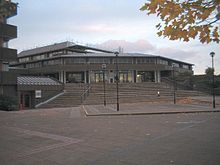
The university has seven libraries across Birmingham on all campuses that contain around 950,000 books and 9,000 print and electronic journals.[55] Kenrick Library, named after William Kenrick in recognition of his role as the first Chairman of Governors when the Polytechnic was formed in 1971, was located at the City North Campus and was the largest of the university's libraries, covering three floors and featuring more than 320,000 books, 2,000 print journals and more than 4,000 electronic journals. A £3 million refurbishment introduced a suite of individual and group study areas.[56] The library closed in May 2018 when the remaining schools based at Perry Barr moved to the City South Campus. Other libraries include:
- Curzon Library (located at the City Centre Campus and houses the Conservatoire library collection);
- Bournville Library;
- Mary Seacole Library (located at the City South Campus);
- Margaret Street Library;
- Vittoria Street Library.
Controversy over Mapplethorpe
In 1998, the university was involved in controversy when a book by photographer Robert Mapplethorpe, Mapplethorpe (1992), was confiscated. A final year undergraduate student was writing a paper on Mapplethorpe's work and intended to illustrate the paper with a few photographs. She took the photographs to the local photo-studio to be developed and the photo-studio informed West Midlands Police because of the unusual nature of the images. The police confiscated the library book from the student and informed the university that the book would have to be destroyed. If the university agreed to the destruction, no further action would be taken.
The university Vice-Chancellor, Peter Knight, took the view—supported by the Senate—that the book was a legitimate book for the university library to hold and that the action of the police was a serious infringement of academic freedom. The Vice-Chancellor was interviewed by the police, under caution, with a view to prosecution under the terms of the Obscene Publications Act, which defines obscenity as material that is likely to deprave and corrupt. The police focused on one particular image, 'Jim and Tom, Sausalito 1977', which depicts one man urinating into the mouth of another.
After the interview with the Vice-Chancellor, a file was sent to the Crown Prosecution Service as the Director of Public Prosecutions (DPP) has to take the decision as to whether or not to proceed with a trial. After a delay of about six months, the affair came to an end when the DPP informed Knight that no action would be taken as "there was insufficient evidence to support a successful prosecution on this occasion". The original book was returned, in a slightly tattered state, and restored to the university library.[57]
Partner institutions

The university runs access and foundation programmes through an international network of associated universities and further education colleges, including:
- Auston Institute of Management, Singapore
- Auston Institute of Management, Sri Lanka
- Birmingham Metropolitan College, UK
- Colombo School of Technology and Management, Sri Lanka
- Continuous Professional Education Centre Limited (CPE), Hong Kong
- Global School of Technology and Management, Singapore
- Guilin University of Technology, China
- ICAT Design & Media College, India
- Institute for Tech and Management (ITM), India
- International College of Business and Technology, Sri Lanka
- Kaplan, Hong Kong
- Kaplan, Singapore
- Nanjing University of Science and Technology, China
- NEXT Campus, Sri Lanka
- Saegis Campus, Sri Lanka
- School for Higher and Professional Education (SHAPE), Hong Kong
- Silpakorn University International College, Thailand
- South Birmingham College, UK
- Wuhan Textile University, China
Academic profile
Research
The university has five Centres of Research Excellence, which are the main focus of its research activity.[58] Following the 2008 Research Assessment Exercise conducted by the Higher Education Funding Council for England, the Birmingham Post reported that more than 70 per cent of research work submitted by Birmingham City University—including in business and management studies, education, English, social work and social policy, and town and country planning—was "officially recognised as of an international standard", and 15 per cent of that work was "rated as world leading". Its art and design submission was among the ten highest ranked in the country, and Birmingham Conservatoire was rated one of the top three conservatoires, and the best outside London.[59] The university was ranked sixty-third based on average assessment scores.[60][61]
Rankings and reputation
| National rankings | |
|---|---|
| Complete (2025)[62] | 97 |
| Guardian (2025)[63] | 97 |
| Times / Sunday Times (2025)[64] | 105 |
The university has a number of courses accredited by Creative Skillset, the government's skills sector council for audio, visual and creative industries.[65] With regard to post-production, the university also has Avid Mentor status,[66] and is the Midlands' accredited training centre for Apple's Final Cut editing software.[67] The School of Media is regarded as the UK's number-one media school to offer both theory- and production-based teaching,[68] and is ranked eleventh in The Guardian University Guide 2010.[69] From the launch of CCNP in 2001, BCU was also the CATC for the CCNP Program within EMEA and has provided CCNP instructor training across Europe, Russia, Israel, Dubai and South Africa.[70]
The School of English is among the top 20 in the UK, according to the 2014 Research Excellence Framework, with 77% of its research being rated nationally or internationally excellent.[71]
For health and social care, Birmingham City University was awarded national recognition as a Centre for Excellence in Teaching and Learning.[72] The Quality Assurance Agency for Higher Education, in its institutional audit and major review of Nursing, Midwifery and Allied Health Professions, gave the university excellent outcomes.[73] The university has an on-site virtual operating suite for health students, the first at a university in England.[74] In the Smithers-Robinson League Table, for initial teacher training, Birmingham City University and three other institutions are consistently ranked top ten.[73] Ofsted inspection scores for teacher education courses are frequently among the best.[72]
In May 2010, the university achieved the highest mark, an Ofsted grade 1 for the quality of training and the management and quality assurance of the training it provides for both its primary and secondary teacher training courses.[75]
Student life
Roughly half of the university's full-time students are from the West Midlands, and a large percentage of these are from ethnic minorities. The university runs access and foundation programmes through an international network of associated universities and further education colleges,[72] and it has the highest intake of international students in the Birmingham area. For 2009 entry, applications rose by 37 per cent from 2008, one of the biggest increases at any university.[76] There are almost six applications per place and course entry requirements range from 200 to 300 UCAS points for all honours programmes; other courses' requirements vary.[74]
Students Union
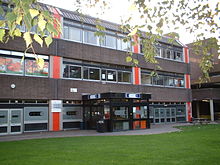
Birmingham City University Students' Union is located at the City Centre Campus. There are several reception offices located at all the university's campuses.[77] It is affiliated with the National Union of Students, and all students are automatically members of the union. Student media comprises a magazine, The Scratch and a television station, Tiger TV.[78] The Students' Union also has close ties with the student and community radio station Scratch Radio,[79] which is housed in the Parkside Building at the City Centre Campus.
The student union of Birmingham Polytechnic was condemned in November 1974 when its council passed a resolution supporting IRA terrorism.[80] The polytechnic's student radio station, Radio G, was the runner-up in the 1989 Guardian/NUS Student Media Awards.[81]
Now Birmingham City Students' Union, it holds elections every year to elect the five full-time Sabbatical Officers who run the Union and act as its Company Directors.
Notable staff and alumni
Current and former staff of the University and its former entities include novelists Jim Crace[82] and Stephen Booth,[83] nurse-author Bethann Siviter, journalist Paul Bradshaw, Nigerian researcher and pollster Bell Ihua, scientist Kevin Warwick,[84] environmentalist Chris Baines, politicians Khalid Mahmood (MP for Perry Barr) and Lynne Jones (former MP for Selly Oak), and former Chief Inspector of Probation for England and Wales Paul McDowell.
Other notable graduates of the University and its predecessor institutions working in broadcasting include children's television presenter Kirsten O'Brien, sports TV presenter Mary Rhodes, radio and TV presenters Fiona Phillips, Zoë Ball, Margherita Taylor and Phil Upton, and investigative journalist Mark Williams-Thomas.[85]
Several work in broadcast journalism, such as Sky News news presenter Marverine Cole[86] and BBC news presenter Charlie Stayt. Art and design alumni include cartoonist Alex Hughes,[87] artist Barbara Walker, fashion designer Betty Jackson,[88] photographer Ravi Deepres and artist Rob Pepper.
Graduates in the performing arts include musicians Roy Priest (formerly of Sweet Jesus) and Nick Duffy, singer-songwriter Stephen Duffy, actors Jimi Mistry, Catherine Tyldesley and Tom Lister, comedian Frank Skinner,[89] singer and The X Factor contestant Rhydian Roberts,[90] and bass guitarist John Taylor, founder of Duran Duran.
References
- ^ [1]
- ^ "Birmingham City University : Birmingham City University appoints new Vice-Chancellor".
- ^ a b c "Where do HE students study?". Higher Education Statistics Agency. Retrieved 23 September 2024.
- ^ United Kingdom. "Birmingham City University : Our History". Bcu.ac.uk. Retrieved 4 February 2013.
- ^ "Education". birminghampost. Retrieved 16 July 2015.
- ^ a b United Kingdom. "Birmingham City University : City Centre Campus expansion – Phase 1". Bcu.ac.uk. Archived from the original on 14 February 2013. Retrieved 4 February 2013.
{{cite web}}: Unknown parameter|deadurl=ignored (|url-status=suggested) (help) - ^ Keogh, Kat (27 November 2012). "University College Birmingham and Newman College to be given university status". Birmingham Mail. Retrieved 13 October 2015.
- ^ "The Complete University Guide 2015". The Complete University Guide. 1 June 2014.
- ^ http://www.timesonline.co.uk/tol/life_and_style/education/good_university_guide/article2166784.ece. Retrieved 16 July 2015.
{{cite news}}: Missing or empty|title=(help) - ^ The Times, Thursday, 13 April 1967; pg. 18; Issue 56914; col A
- ^ Display Ad 202 – No Title. (16 November 1969). The Observer
- ^ Our Education Correspondent. The Guardian (1959–2003). London (UK): 3 September 1970. p. 5
- ^ a b The Times, Friday, 1 January 1971; pg. 4; Issue 58061; col A
- ^ a b The Guardian (1959–2003). London (UK): 4 January 1972. p. 9
- ^ The Times, Thursday, 8 June 1972; pg. III; Issue 58499; col A "Education battered in political arena"
- ^ a b The Times, Wednesday, 5 January 1972; pg. 12; Issue 58367; col B
- ^ Peter Wilby. The Observer (1791- 2003). 6 May 1973. p. 23
- ^ JOHN FAIRHALL Education Correspondent. The Guardian (1959–2003). London (UK): 20 March 1976. p. 4
- ^ John Fairhall Education Correspondent. The Guardian (1959–2003). London (UK): 22 February 1979. p. 5
- ^ The Guardian (1959–2003). London (UK): 23 July 1987. p. 6
- ^ Michael Smith. The Guardian (1959–2003). London (UK): 11 July 1989. p. 25
- ^ "Amba Wear – The No.1 T-shirt printer in Birmingham". Ambafrogdesign.co.uk. Archived from the original on 16 May 2014. Retrieved 4 February 2013.
{{cite web}}: Unknown parameter|deadurl=ignored (|url-status=suggested) (help) - ^ "Universities consider merger". BBC News. 27 November 2003. Retrieved 6 July 2008.
{{cite news}}: Italic or bold markup not allowed in:|work=(help) - ^ MacLeod, Donald (26 November 2003). "Row over Birmingham universities' merger proposals". The Guardian. London.
- ^ Donald MacLeod. "Aston merger moves a step closer". The Guardian. Retrieved 16 July 2015.
- ^ "UCE proposes Aston merger". Times Higher Education. Retrieved 16 July 2015.
- ^ Donald MacLeod. "Row over Birmingham universities' merger proposals". The Guardian. Retrieved 16 July 2015.
- ^ a b [2] Archived 23 December 2012 at archive.today
- ^ "University of Central England no more; we are now Birmingham City University". Birmingham City University. Retrieved 6 February 2008.[permanent dead link]
- ^ a b "University of Birmingham Council: 4 July 2007 Unconfirmed Minutes" (PDF). University of Birmingham. 4 July 2007. p. 4. Retrieved 20 September 2007.
- ^ [3] Archived 18 January 2009 at the Wayback Machine
- ^ "New name for city university". BBC Birmingham. 1 October 2007. Retrieved 2 October 2007.
- ^ "Freedom of Information request relating to change of name" (PDF). Birmingham City University. Retrieved 27 November 2009.
- ^ "Birmingham City Students' Union". Archived from the original on 11 February 2010.
{{cite web}}: Unknown parameter|deadurl=ignored (|url-status=suggested) (help) - ^ "Birmingham City University name change". Birmingham City University. 17 September 2007. Archived from the original on 15 December 2007. Retrieved 1 October 2007.
{{cite web}}: Unknown parameter|deadurl=ignored (|url-status=suggested) (help) - ^ a b Shahid Naqvi (1 October 2007). "UCE announces name change". Birmingham Post. Retrieved 2 October 2007.
- ^ "2007/2008 Name Change Costs" (PDF). What Do They Know. Birmingham City University. 17 July 2009. Retrieved 27 November 2009.
- ^ Tony Collins (1 October 2007). "New name for Brum's UCE". Birmingham Mail. Retrieved 2 October 2007.
- ^ United Kingdom. "Birmingham City University : Bournville". Bcu.ac.uk. Retrieved 4 February 2013.
- ^ "Birmingham City University embraces Oracle ERP software". SearchERP. Retrieved 15 November 2017.
- ^ [4] Archived 3 June 2011 at the Wayback Machine
- ^ "Welcome to The Doug Ellis Sports Centre". Citynorthsportscentre.com. Retrieved 4 February 2013.
- ^ "Birmingham Post: Business news, local news, expert opinion". Retrieved 16 July 2015.
- ^ U (13 April 2015). "Birmingham City University : Accommodation". Bcu.ac.uk. Retrieved 13 October 2015.
- ^ [5] Archived 21 May 2013 at the Wayback Machine
- ^ "Birmingham City University : Sir Lenny Henry appointed as Chancellor of Birmingham City University". bcu.ac.uk. Retrieved 21 July 2016.
- ^ "Birmingham City University : Schools and Faculties". Bcu.ac.uk. Retrieved 13 October 2015.
- ^ "Birmingham Conservatoire". Birmingham City University. Retrieved 6 March 2008.
- ^ "Birmingham School of Acting merges with UCE Birmingham". Birmingham School of Acting. 30 May 2005. Archived from the original on 4 December 2007. Retrieved 6 March 2008.
{{cite web}}: Unknown parameter|deadurl=ignored (|url-status=suggested) (help) - ^ "PME School of Media : Welcome to Birmingham School of Media". Mediacourses.com. Retrieved 4 February 2013.
- ^ [6] Archived 26 August 2009 at the Wayback Machine
- ^ "Birmingham City University Faculty of Health". Birmingham City University. Retrieved 6 March 2008.
- ^ "Birmingham City University Faculty of Education". Birmingham City University. Archived from the original on 17 October 2007. Retrieved 6 March 2008.
{{cite web}}: Unknown parameter|dead-url=ignored (|url-status=suggested) (help) - ^ "TEE". Birmingham City University. Retrieved 1 January 2010.
- ^ "Birmingham City University. Library and Learning Resources Homepage". Library.bcu.ac.uk. Archived from the original on 27 January 2013. Retrieved 4 February 2013.
{{cite web}}: Unknown parameter|dead-url=ignored (|url-status=suggested) (help) - ^ [7] Archived 5 October 2012 at the Wayback Machine
- ^ "After a year out on loan Mapplethorpe book is set to return to library shelves". 10 August 1999. Archived from the original on 23 August 2006. Retrieved 6 March 2008.
- ^ "Research". Birmingham City University. Archived from the original on 1 March 2008. Retrieved 6 March 2008.
{{cite web}}: Unknown parameter|deadurl=ignored (|url-status=suggested) (help) - ^ "Education". birminghampost. Retrieved 16 July 2015.
- ^ "Education – The Times". Retrieved 16 July 2015.
- ^ Asthana, Anushka. "Education" (XLS). The Times. London. Retrieved 26 April 2010.
- ^ "Complete University Guide 2025". The Complete University Guide. 14 May 2024.
- ^ "Guardian University Guide 2025". The Guardian. 7 September 2024.
- ^ "Good University Guide 2025". The Times. 20 September 2024.
- ^ "Birmingham School of Media : About Us". Retrieved 16 July 2015.
- ^ [8] Archived 4 June 2009 at the Wayback Machine
- ^ [9] Archived 7 January 2009 at the Wayback Machine
- ^ "Birmingham School of Media". Retrieved 16 July 2015.
- ^ "University guide 2010: Media studies, communications and librarianship". The Guardian. London. 12 May 2009. Retrieved 26 April 2010.
- ^ "Certified academies and Testing Centres". Catcemea.org.uk. Retrieved 13 October 2015.
- ^ "Research - School of English - Birmingham City University". www.bcu.ac.uk.
- ^ a b c Asthana, Anushka (28 May 2009). "Profile Birmingham City University". The Times. London. Retrieved 26 April 2010.
- ^ a b "Birmingham City University". Retrieved 16 July 2015.
- ^ a b "Birmingham City University". The Independent. London. 15 July 2009. Retrieved 26 April 2010.
- ^ "Birmingham City University". Retrieved 16 July 2015.
- ^ Asthana, Anushka (13 September 2009). "Profile Birmingham City University". The Times. London. Retrieved 26 April 2010.
- ^ "Birmingham City University Students' Union". Birminghamcitysu.com. 22 July 2015. Archived from the original on 2 June 2010. Retrieved 13 October 2015.
{{cite web}}: Unknown parameter|deadurl=ignored (|url-status=suggested) (help) - ^ "Media". Birmingham City Students' Union. Retrieved 10 February 2014.
- ^ "Birmingham City University Students' Union". Birminghamcitysu.com. 22 July 2015. Archived from the original on 17 April 2009. Retrieved 13 October 2015.
{{cite web}}: Unknown parameter|deadurl=ignored (|url-status=suggested) (help) - ^ GARETH PARRY. The Guardian (1959–2003). London (UK): 28 November 1974. p. 30
- ^ David Gow Education Editor. The Guardian (1959–2003). London (UK): 30 October 1989. p. 5
- ^ "Novelist Crace to unveil 'fabulous' £3m library revamp". Birmingham City University. 26 September 2007. Archived from the original on 25 October 2007. Retrieved 2 October 2007.
{{cite web}}: Unknown parameter|deadurl=ignored (|url-status=suggested) (help) - ^ "Stephen Booth – biography". Retrieved 16 July 2015.
- ^ Warwick,K, Q & A at Seminar in Birmingham City University, 20 February 2008
- ^ "Alumni".
- ^ [10] Archived 23 September 2008 at the Wayback Machine
- ^ [11] Archived 16 April 2009 at the Wayback Machine
- ^ [12] Archived 12 February 2009 at the Wayback Machine
- ^ [13] Archived 25 May 2013 at the Wayback Machine
- ^ "Don't get rid of X Factor Rhydian, says Birmingham lecturer". Birmingham City University. 15 October 2007. Archived from the original on 5 March 2008. Retrieved 6 March 2008.
{{cite web}}: Unknown parameter|deadurl=ignored (|url-status=suggested) (help)
External links
- Articles to be merged from September 2018
- Birmingham City University
- Public universities and colleges in the United Kingdom
- Educational institutions established in 1971
- 1971 establishments in England
- Buildings and structures in Birmingham, West Midlands
- Culture in Birmingham, West Midlands
- History of Birmingham, West Midlands
- Education in Birmingham, West Midlands

